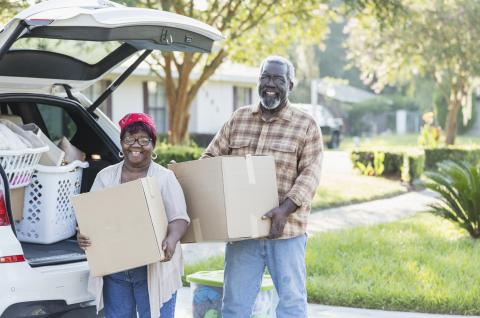Spring Cleaning? Think About Downsizing!
It’s good to keep up with that task over the years. As we grow older, we are likely to move to a smaller place—maybe a condo, or a senior living residence. The kids are grown, and we no longer need all those bedrooms. Every year, the yard seems to need more attention. We’ve retired, and we’d like to travel more without worrying about our home. And sometimes circumstances force a faster move. We might develop chronic conditions that make keeping up our old home more challenging. We might want to quickly move to a supportive senior living environment, such as assisted living.
But what to do with a lifetime of furniture and possessions? Baby boomers are discovering that their default plan—give it all to the kids—isn’t playing very well with the more minimalist younger generation! Maybe you have heard that younger people aren’t into the brown wood furniture, knickknacks and silver that their parents have accumulated. They may not even want their own childhood artwork, sports trophies or photos. Better have those conversations and make plans early on.
Here are questions to ask as you decide what to keep, what to part with, and what to do with items you no longer need or have space for:
If you’ve planned a move, what will the space limitations be? What furniture and personal belongings will fit? What can you do without? Measure spaces and make a floor plan. Crowding too much furniture into the smaller space won’t make for comfortable living. And planning ahead will prevent you from running up a big bill at a public storage company because you didn’t complete the task by moving day.
What should you do with unwanted possessions? Give family the first crack at useful, valuable items—for example, a grandchild who is just setting up living in their first apartment might want furniture. You may wish to give some items to charitable organizations. You might hold a garage sale, sell items online, or give things away on a Buy Nothing or Freecycle group.
What if I have things that might be valuable? Sadly, things we treasure may not have the same value for others. On the other hand, we’ve all read about people who unknowingly tossed out first-edition comic books, or others who found valuable artwork at a thrift store. When in doubt, call in an expert. Appraisers, antique and collectibles dealers, auction houses, consignment shops and estate buyers can help you get a fair price for certain items.
Who can help? If you are worried about the work, decisions and arrangements that need to be made, ask for help. Family and friends might pitch in. Professionals can help, too—for example, an aging life care manager (also called a geriatric care manager). There are even senior move managers who specialize in assisting with this process. If you’re planning a move to a senior living community, ask what they recommend.
What about heirlooms and mementos?
This can be the hardest decision of all for seniors who are downsizing. Most of us have accumulated photo albums, old home movies, souvenirs of travels and family events, collections, and antiques that have been in the family for generations. Here are four things to remember when sorting through items that have sentimental value:
- Consult potential heirs. If you have furniture, mementos and heirlooms that you won’t be keeping but that might be of interest to your children, grandchildren, nieces or nephews, invite them to come over and make some selections. Be clear about your timeline. This visit can be a wonderful opportunity to share old memories and family stories. It might even be a good time to reconnect with relatives you haven’t seen in years. Maybe your own adult children aren’t interested the dishes your grandparents brought over when emigrating from Ireland, but your cousin’s children could be avid family historians who would love those family treasures.
- Don’t move too fast or too slowly. Discarding items with sentimental value can cause real pain and regret in the family. But if you cling too much to items you’ve accumulated over the years, you may be burdening yourself with possessions that serve no good purpose.
- Go digital with old home movies, photos and slides. These can now be converted easily and inexpensively. Perhaps a grandchild or other family member would be a willing volunteer in curating a collection.
- Take the time to label pictures, heirlooms and mementos. This way, others can appreciate their significance—a real gift to your family. Studies show sentimentality about family tends to skip a generation. How emotionally gratifying to imagine a not-yet-born family member treasuring the souvenir spoon your great-great grandmother bought at the 1893 Chicago World’s Fair!
Everyone who has been through this process agrees: The earlier you start, the better. As soon as you begin considering a move, begin sorting junk drawers and taking inventory of unopened boxes in the attic. Keep the conversation with family going throughout the process. This way, downsizing will seem more like what it really is: rightsizing.
